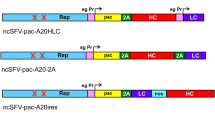Abstract
The p53 molecule might serve as a common tumor-associated antigen, as the tumor suppressor gene p53 is mutated and the p53 protein is often over-expressed in tumor cells. We report that effective immunity to p53 can be induced through an idiotypic network by immunization of mice with a monoclonal antibody (PAb-240) specific for mutated p53, or with a peptide derived from the complementarity determining region (CDR) 3 of the variable domain of the light chain (VL) of this antibody. The immunized mice produced IgG antibodies to p53 and mounted a cytotoxic reaction to a tumor line bearing mutated p53. The idiotypically immunized mice were resistant to challenge with the tumor cells. Thus antibodies to p53 might serve as immunogens for activating resistance to some tumors. At the basic level, these findings indicate that a network of p53 immunity may be organized naturally within the immune system.
This is a preview of subscription content, access via your institution
Access options
Subscribe to this journal
Receive 12 print issues and online access
$209.00 per year
only $17.42 per issue
Buy this article
- Purchase on Springer Link
- Instant access to full article PDF
Prices may be subject to local taxes which are calculated during checkout
Similar content being viewed by others
References
Hollstein, M., Sidransky, D., Vogelstein, B. & Harris, C.C. p53 mutations in human cancers. Science 253, 49–53 (1991).
Levine, A. p53, the cellular gatekeeper for growth and division. Cell 88, 323–331 (1997).
Bertholet, S., Iggo, R. & Corradin, G. Cytotoxic T lymphocyte responses to wild type and mutant mouse p53 peptides. Eur. J. Immunol. 27, 798–801 (1997).
Vierboom, M.P.M. et al. Tumor eradication by wild-type p53-specific cytotoxic T lymphocytes. J. Exp. Med. 186, 695–704 (1997).
Nisonoff, A. Idiotypes: concepts and applications. J. Immunol. 147, 2429–2438 (1991).
Bona, C.A. Internal image concept revisited. Proc. Soc. Exp. Biol. Med. 213, 32–40 (1996).
Fields, B. et al. Molecular basis of antigen mimicry by an anti-idiotype. Nature 374, 739–742 (1995).
Nepom, G. et al. Identification of a hemaglutinin-specific idiotype assoicated with reovirus recognition shared by lymphoid and neural cells. J. Exp. Med. 11, 155–167 (1982).
Nepom, G. et al. Virus-binding receptors: similarities to immune receptors as determined by anti-idotypic antboides. Surv. Immunol. Res. 1, 255–261,1982.
Eliyahu, D. et al. Meth A fibrosarcoma cells express two transforming mutant p53 species. Oncogene 3, 313–321 (1988).
Wucherpfenning, K.W. & Strominger, J.L. Molecular mimicry in T cell mediated autoimmunity: Viral peptides activate human T cell clones specific for myelin basic protein. Cell 80, 695–705 (1995).
Coffman, R. et al. The role of helper T cell products in mouse B cell differentiation and isotype regulation. Immunol. Rev. 102, 5–28 (1988).
Cohen, I. The cognitive paradigm and the immunological homunculus. Immunol. Today 13, 490–494 (1992).
Wolkowicz, R., Elkind, N.B., Ronen, D. & Rotter, V. The DNA binding activity of wild type p53 is modulated by blocking its various antigenic epitopes. Oncogene 10, 1167–1174 (1995).
Gannon, J.V., Greaves, R., Iggo, R. & Lane, D.P. Activating mutations in p53 produce a common conformational effect. A monoclonal antibody specific for the mutant form. Embo J. 9, 1595–1602 (1990).
Munro, S. & Pelham, H.R. An Hsp70-like protein in the ER: identity with the 78 kd glucose-regulated protein and immunoglobulin heavy chain binding protein. Cell 46, 291–300 (1986).
Orlandi, R., Gussow, D.H., Jones, P.T. & Winter, G. Cloning immunoglobulin variable domains for expression by the polymerase chain reaction. Proc. Natl. Acad. Sci. USA 86, 3833–3837 (1989).
Arai, N. et al. Immunologically distinct p53 molecules generated by alternative splicing. Mol Cell Biol 6, 3232–3239 (1986).
Coligan, J.E., Kruisbeek, A.M., Margulies, D.H., Shevach, E.M. & Strober, W. Current Protocols in Immunology (John Wiley & Sons, Inc., New York, 1994).
Author information
Authors and Affiliations
Rights and permissions
About this article
Cite this article
Ruiz, P., Wolkowicz, R., Waisman, A. et al. Idiotypic immunization induces immunity to mutated p53 and tumor rejection. Nat Med 4, 710–712 (1998). https://doi.org/10.1038/nm0698-710
Received:
Accepted:
Issue Date:
DOI: https://doi.org/10.1038/nm0698-710
This article is cited by
-
An MVA vaccine overcomes tolerance to human p53 in mice and humans
Cancer Immunology, Immunotherapy (2007)
-
Autoantigen complementarity: a new theory implicating complementary proteins as initiators of autoimmune disease
Journal of Molecular Medicine (2005)
-
Immunotherapy for colorectal cancer
Current Oncology Reports (2001)
-
Use of the anti-idiotype antibody vaccine TriAb after autologous stem cell transplantation in patients with metastatic breast cancer
Bone Marrow Transplantation (2000)
-
Idiotype vaccines: Forgotten but not gone
Nature Medicine (1998)



